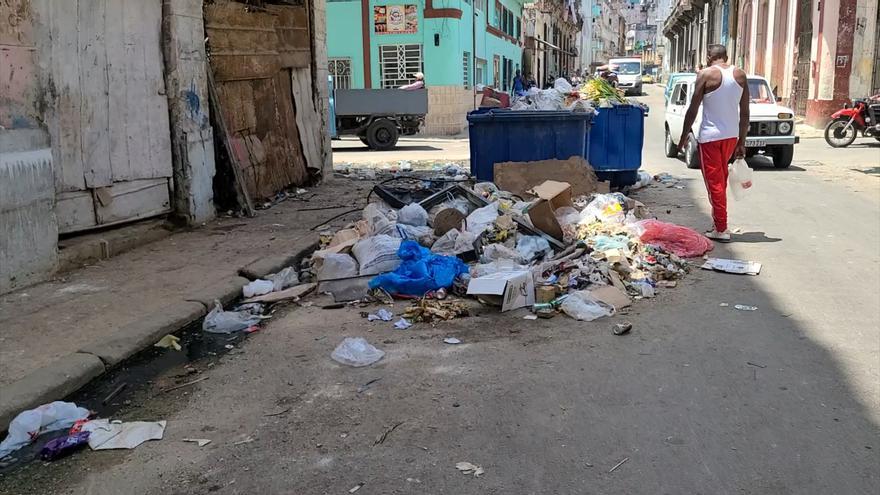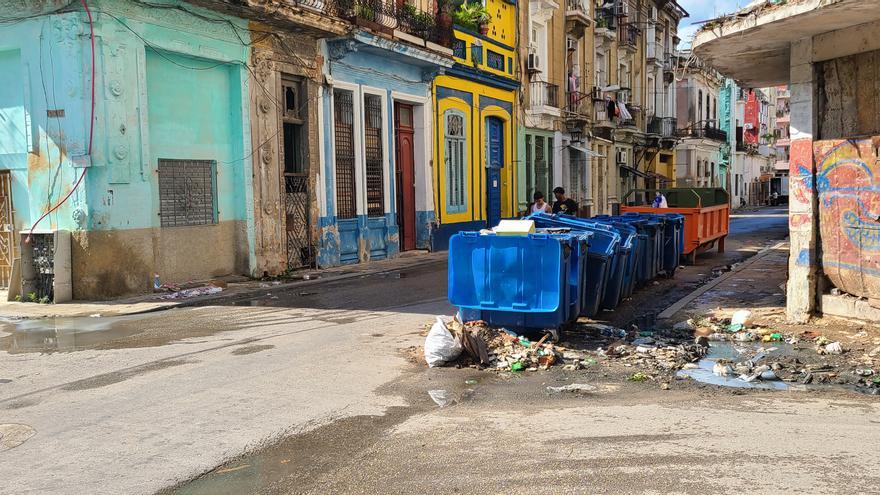
![]() 14ymedio, Nelson García, Havana, 31 August 2023 — Celia holds her breath every day when she passes by the corner of Industria y Ánimas, in the neighborhood of Colón (Centro Habana). The garbage containers are overflowing with waste and debris. The sidewalk stopped being passable some time ago, and pedestrians mix with the vehicles and taxi-bikes on the street. Rusty metal sheets cover the entrances to the building in front of which the mountain of waste grows.
14ymedio, Nelson García, Havana, 31 August 2023 — Celia holds her breath every day when she passes by the corner of Industria y Ánimas, in the neighborhood of Colón (Centro Habana). The garbage containers are overflowing with waste and debris. The sidewalk stopped being passable some time ago, and pedestrians mix with the vehicles and taxi-bikes on the street. Rusty metal sheets cover the entrances to the building in front of which the mountain of waste grows.
“Before, when a hurricane was coming, the Communal companies picked up the garbage and cleaned the sewers, but with Idalia they didn’t even show up around here,” complained Celia, while pointing to the row of crammed-full garbage cans. Near them, a huge cargo container of a truck contains construction debris, parts of broken furniture and the garbage generated by a nearby business that sells animals for religious sacrifice.
Despite the ugliness of the scene and the bad smells, people who pass by react normally. Dirt has become so familiar in Havana that the surprising thing is those blocks where cleanliness, painted facades and order contrast with the rest of the city. People seem to have become accustomed to living with the filth due to the inability of the authorities to collect it in time.
Garbage is also the way for many to survive. The dumpster divers search the containers for raw materials to sell, empty perfume bottles to refill to scam some unsuspecting customer, food waste to feed the pigs, pieces of appliances that serve to repair others and even clothes that help protect them from the breeze and humidity during the early hours of the morning. Where some see rubbish, others find their means of sustenance.

Garbage in Havana is also one of the most obvious ways to measure the state of the economy of the Cuban capital. During the crisis of the 90s, garbage containers had only what could no longer be used for almost anything. Not even pieces of old wood were thrown into the cans, because people used them as firewood to cook. Finding leftover food among the waste was a miracle in what Fidel Castro named the Special Period.
Then, the garbage of Havana began to fill with plastic bags that until then had been considered a status symbol for those who bought in dollar stores. Little by little, with the opening to private businesses, the expansion of markets in convertible pesos and the arrival of more tourists, cans, plastic containers and boxes of electronic devices appeared on the streets.
“The garbage smelled different,” recalls Genaro, 68 years old and a resident a few meters from the corner of Industria and Ánimas. In those years, this habanero and his two sons had a small business collecting empty cans of beer and soda. “There wasn’t the poverty there is now. You could get something from selling in the cans, but it’s not worth it anymore,” he tells 14ymedio. “Even the garbage is in crisis.”
Some stone faces peep out on the facade of the building on the corner in front of the containers. They wear curly wigs that mimic some European headdress, which are totally out of tune with the destroyed balconies, the thresholds without doors and a couple of bushes that have grown on the eaves of the semi-ruined building. From up there they look like the guardians of the waste, the watchmen of the city’s offal.
The dirt also affects entrepreneurs. Lourdes has seen the clientele of her cafeteria in the neighborhood of Colón languish to the same extent that the garbage pile in front of her place grows. “Who is going to want to have a milkshake or eat a pizza with this plague?” she asks. The journey of the neighbors to eradicate the huge garbage pile has taken them from the meetings with the Delegate of People’s Power to “writing letters to the Council of State,” the woman tells this newspaper.
“Who is going to want to have a milkshake or eat a pizza with this plague?” she asks
The result of the complaints has been null. Over the years, the sidewalk around the pile of garbage has disappeared, “because instead of picking it up with the right trucks they bring a bulldozer and scoop it up,” Lourdes says. Water accumulates in the hole left by the heavy machinery, and “a mosquito farm is formed that does not allow us to live.”
Hanging from the ceiling of the cafeteria, Lourdes has put some transparent plastic bags with water that, someone told her, “help to scare away the flies.” But the curious invention doesn’t seem to be working. This Wednesday several insects were perched on the bags and flew down on the food of the few customers who came to buy. The owner’s hand constantly waved a cardboard to ward off the flying intruders, which sometimes went from the waste thrown on the street to the meringue of some small sweets.
At noon, an impeccable white police patrol car passed in front of Lourdes’ house with a camera installed on the roof. With the windows closed and somewhat fogged, revealing the air conditioning inside the vehicle, the uniformed men roamed the streets of a neighborhood where poverty and discontent are the breeding grounds for complaint and protest. The wheels of the car passed over some garbage bags and continued on their way to the next block. And like that, four or five times a day.
Translated by Regina Anavy
____________
COLLABORATE WITH OUR WORK: The 14ymedio team is committed to practicing serious journalism that reflects Cuba’s reality in all its depth. Thank you for joining us on this long journey. We invite you to continue supporting us by becoming a member of 14ymedio now. Together we can continue transforming journalism in Cuba.
